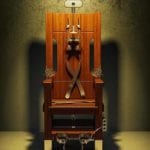 Weird Stuff
Weird Stuff  Weird Stuff
Weird Stuff  The Arts
The Arts 10 Extremely Strange Designs of Common Musical Instruments
 Crime
Crime 10 Jaw-Dropping Prison Escapes Involving Helicopters
 Technology
Technology Using 10 Well-Known Technologies in the Most Unusual Ways
 Miscellaneous
Miscellaneous 10 Badly Damaged Trademarks That May Never Recover
 Books
Books 10 Famous Poisoned Pen Biographies
 History
History 10 of the Most Unusual Deaths Ever Recorded in History
 Humans
Humans 10 Amazing Origins of Human Body Parts
 Crime
Crime 10 Weirdly Specific Crime Waves from the Last Two Centuries
 Creepy
Creepy 10 Creepy Ancient Wooden Idols
 Weird Stuff
Weird Stuff 10 Strange Things Found Inside Other Things
 The Arts
The Arts 10 Extremely Strange Designs of Common Musical Instruments
 Crime
Crime 10 Jaw-Dropping Prison Escapes Involving Helicopters
Who's Behind Listverse?

Jamie Frater
Head Editor
Jamie founded Listverse due to an insatiable desire to share fascinating, obscure, and bizarre facts. He has been a guest speaker on numerous national radio and television stations and is a five time published author.
More About Us Technology
Technology Using 10 Well-Known Technologies in the Most Unusual Ways
 Miscellaneous
Miscellaneous 10 Badly Damaged Trademarks That May Never Recover
 Books
Books 10 Famous Poisoned Pen Biographies
 History
History 10 of the Most Unusual Deaths Ever Recorded in History
 Humans
Humans 10 Amazing Origins of Human Body Parts
 Crime
Crime 10 Weirdly Specific Crime Waves from the Last Two Centuries
 Creepy
Creepy 10 Creepy Ancient Wooden Idols
10 Men Who Suffered Horrible Executions
Before the rise of modern humanism in the mid-17th century, offending the ruling class throughout Europe and Asia could result in a man being sentenced to a horribly brutal execution. These days, most of the civilized world denounces such “cruel and unusual punishments,” and they are outlawed. But long ago, public torture executions were the norm for men found deserving of them.
Related: 10 Barbaric Forms Of Punishment Still Practiced Today
10 Manius Aquillius (88 BC)
Aquillius rose to prominence as a general in the late Roman Republic and distinguished himself in 101 BC at the Battle of Aquae Sextae.
In 88 BC, he was defeated in battle at Protostachium and attempted to flee back to Italy. He made it as far as the island of Lesbos, where the Greek locals apprehended him and turned him over to Mithridates, his enemy. Aquillius was placed on a donkey and paraded to his humiliation back to the city of Pergamon.
There, he was executed by having molten gold poured down his throat. The specifics of this method of execution were not recorded, but it can be safely assumed that the gold instantly melted its way through his internal organs. This would have caused his esophagus and stomach to explode, possibly out through his abdomen.[1]
9 Robert-Francois Damiens (1757)
Damiens was 41 years old when, on January 5, 1757, he attempted to assassinate King Louis XV.
On that day, as King Louis was leaving the Palace of Versailles at 4 pm, Damiens managed to get through his bodyguards and stabbed the king in the chest with a small penknife. Louis was wearing thick winter clothing and was barely wounded, the blade only penetrating to half an inch, but as Damiens was restrained and arrested, Louis called for a Confessor and apologized to his wife for all the extramarital affairs he had had.
The Parlement convicted Damiens, and on March 28, he was tortured for four hours; his legs and feet were crushed in wood boots, then red-hot pinchers were used to tear his flesh off. Into these wounds were poured molten lead and boiling oil. His right hand was burned with molten sulfur. Then he was handed over to Charles Sanson, the royal executioner, who tied Damiens’s naked body to four horses in the middle of the Place de la Greve, where hundreds of onlookers, including Giacomo Casanova, watched.
Sanson sliced off Damiens’s genitals and burned them, then ordered the horses led away in four directions to rip his arms and legs out of their sockets. But Damiens’s joints proved too tough. So Sanson sliced deeply into his armpits and groin; then, the horses were led away again and ripped him to pieces. It was reported that Damiens, now just a torso, was still alive and screaming when he was thrown into a fire.[2]
8 György Dózsa (1514)
Dózsa was a cavalry captain in what is now Belgrade. In 1514, the Hungarian chancellor returned from Rome with a papal bull ordering that an army be raised to defeat the Ottomans. Dózsa was given this task and, within only a few weeks, had assembled an army of some 40,000 peasants.
The nobility, however, did not provide the peasants with any food, clothing, or weapons and still demanded that they go into battle against the Ottomans. Eventually, the peasant “crusaders” revolted against their own noblemen and intended to defeat the Hungarian nobility, even the king.
Dózsa sided with the peasants, and their rebellion quickly attained the scope of a nationwide revolution. King Vladislaus responded by hastily assembling a mercenary army. Throughout the summer of 1514, Dózsa captured several cities and seized cannons. The whole of the Hungarian nobility descended upon him and defeated his army in July. Dózsa was captured and executed by being forced to sit naked on a red-hot iron throne and wear a red-hot iron crown and hold a red-hot iron scepter.
This was to mock his royal ambition. His younger brother was then hacked to death before him. Then pliers were heated in a fire and used to tear his flesh off. Nine of his rebel followers, having been starved beforehand, were ordered to approach the throne and bite off and swallow his flesh where the pliers had cooked it. The few who refused were cut to pieces before the others, who then complied. After they had eaten pieces of his flesh, they were set free. Dózsa was cooked to death on the throne.[3]
7 Bessus (329 BC)
Bessus was the Satrap (Governor) of the Bactrian province in the far east of Darius’s Persian Empire when Alexander the Great invaded. As Alexander pursued Darius, the latter fled to Bactria, where he tried to raise another army. Still, Bessus attempted to convince Darius to turn over military authority to him. When Darius refused, Bessus speared him and left him mortally wounded as they fled.
This disappointed Alexander, who wanted to capture Darius alive. He pursued Bessus deeper eastward across Bactria. Bessus declared himself Artaxerxes V, King of Asia, and tried to raise an army. However, he did not have enough time and continued his flight over the Hindu Kush. In Nautica (near Shahrisabz, Uzbekistan), Bessus’s own officers arrested him and handed him over to the pursuing Macedonians.
Bessus was taken, naked and bound, to Ptolemy, one of Alexander’s generals, who had Bessus scourged severely in the public square of a village. Then Bessus’s nose and ears were cut off, a traditional Persian punishment for treason.
He was then taken back to Ecbatana, where Alexander ordered him executed by bending two large sapling trees to the ground and tying his arms and legs to them, one side to each tree. The trees were then released and sprang back up, slowly pulling Bessus’s body apart over the course of several days.[4]
6 Peter Niers (1581)
Niers was a German serial killer executed on September 16, 1581, in Neumarkt in der Oberpfalz, about 25 miles (40 kilometers) southeast of Nuremberg. The locals greatly feared him as a powerful black magician in league with the Devil. It is known with certainty that he was one of the ringleaders of a thief/murderer guild roaming the German countryside for years. He was caught in 1577 and tortured into confessing 75 acts of murder but subsequently escaped by unknown means.
He was finally caught along with several other thieves and murderers in Neumarkt, where he stayed at an inn. During three days of torture, he eventually confessed to 544 murders and cannibalism. On the first day, pincers were used to tear strips of flesh from all over his body, and hot oil was then poured into these wounds. On the second day, his feet were smeared with hot oil and held over hot coals, thus roasting them to bones.
On the third day, he was broken on the wheel. The procedure of the breaking wheel varied over time and from place to place. In his case, he was tied face-up and naked to raised wood stakes on the ground, which elevated his limbs a few inches. A large, iron-rimmed wagon wheel was then lifted over him and slammed down on his arms and legs a total of 42 times, pulverizing the bones from the hands to the shoulders and the feet to the hips. Then, rather than twist his shattered limbs around and through the rim and spokes of the wheel, they were simply hacked off while he was still alive.[5]
5 Mithridates (401 BC)
Mithridates killed Cyrus, the younger brother of Artaxerxes II, in battle in 404 BC. Plutarch states that Artaxerxes was very pleased Cyrus was dead and gave Mithridates lavish gifts and asked him to keep everything a secret so the king could claim he had killed Cyrus.
Mithridates got drunk at a feast and boasted of Cyrus’s death by his own hand. When Artaxerxes heard this, he was so infuriated that he ordered Mithridates executed as follows. Two canoes were carved so they would fit together, and into one, Mithridates was laid naked and smeared head to toe with milk and honey. He was forced to drink it some as well.
Then the other boat was secured over him so that his hands, feet, and head protruded. In this state, he was left moored in a lake for days. Flying insects found him and began consuming the milk and honey all over his body, biting and stinging as they did so. The next day, the top boat was removed, and he was again smeared with milk and honey and forced to eat more, then left floating in the lake.
He eventually began to urinate and defecate on himself in the boat, and this attracted more insects, which then began to enter his body through his various orifices and nest inside him, laying eggs that hatched. Thus, the vermin ate through his eyes and invaded his sinuses. In this condition, he died after 17 days of torment.[6]
4 The Brothers d’Aunay (1314)
Gautier and Phillip of Aunay were two knights of the French court of Phillip IV. In 1313, Phillip’s daughter, Queen Isabella of England, gave embroidered purses to her brothers, Louis and Charles, and their wives, Blanche and Margaret. Later that year, she and King Edward II held a large banquet in London for their French guests. Isabella noticed that the purses she had given Blanche and Margaret were being carried by the Brothers d’Aunay.
Isabella suspected her two sisters-in-law were having illicit affairs and told her father the next year. He placed the two brothers under surveillance. The knights tended to come and go often at the Tou de Nesle, a Parisian guard tower built by Phillip II. The whole incident became known as the Tour de Nesle Affair. Phillip eventually announced the adultery in public and had the men and women arrested.
Blanche and Margaret were found guilty, their heads were shaved, and they were imprisoned for life. Gautier and Phillip of Aunay were tortured into confessing their guilt and subsequently executed for the crime of “lèse-majesté,” that is, “to do wrong to majesty.” This was seen as an extremely offensive form of treason requiring the severest punishment.
Accordingly, the brothers were castrated, and their genitals thrown to dogs. Then, they were flayed alive, suffered molten lead and sulfur poured onto their exposed flesh, broken on the wheel, and finally beheaded.[7]
3 The Alcaid Melec (1705)
Melec was a governor (Alcaid) under the sultan of Morocco, Moulay Ismail ben Sharif. In 1705, one of the sultan’s sons, Moulay Muhammad, attempted a rebellion led by Melec, among others. Once the rebellion was put down, Melec was deemed most responsible and deserved extreme punishment. The sultan’s wife was furious that Melec had beheaded one of her cousins, Ali Bouchasra.
Thus, in September or October, Moulay Ismail asked his chief carpenter if his saws were capable of cutting a person in half, and the carpenter replied that they were. The carpenter was then given the job of executioner. He asked whether Melec should be sawed in half sagittally (along the spine) or transversely (across the waist). Ismail answered sagittally, beginning at the head.
The carpenter packed two saws in cloth so Melec would not know how he was to be executed (lest he attempted to escape), and Melec was taken to the public square where as many as 4,000 relatives and friends had gathered. Melec, calmly smoking his pipe, was stripped naked and tied face-up to a board laid across a saw horse.
The executioners intended to begin at his head, but Bouchasra’s sons said they should start between Melec’s legs lest he died too quickly. Melec screamed horribly as the blade slowly cut him in half along his spine until it reached his navel. He was still conscious and begged for water when the executioners put the blade to his head and slowly sawed him in two.[8]
2 Jan van Leiden, Bernhard Krechting, and Bernhard Knipperdolling (1536)
These three men were ringleaders in the Munster Rebellion. They attempted to overthrow the Catholic hegemony in favor of Anabaptist Protestantism in Germany. They kicked the Bishop-Mayor, Franz von Waldeck, out of the city. He immediately assembled a mercenary army and laid siege. The Protestants were led by Jan Matthys until he was killed outside the city walls.
The siege lasted over a year, and most of the residents were starving as a result. On June 24, 1535, Waldeck’s army finally broke through the walls and retook control. Knipperdolling and Krechting were apprehended immediately. Jan was found hiding in a basement.
On January 22, 1536, they were taken up onto a makeshift platform in the market square, tied to an iron stake, and fitted with iron collars so they could not move. Iron tongs were then heated until red-hot. These were bolted in the center like scissors and shaped like modern-day spaghetti claws.
Jan was stripped to his waist, and his flesh ripped off, one red-hot bite at a time, for the space of an entire hour. Knipperdolling could not see him but could hear him howling in agony as his flesh was plucked off down to his bones. Knipperdolling attempted to commit suicide by choking himself with his iron collar. He was then tied up in such a way as to immobilize him.
After a whole hour of suffering, his flesh torn off in great, pinching chunks, Jan’s tongue was torn completely out of his throat. Then a red-hot dagger was shoved into his heart. Then it was Knipperdolling’s turn for one hour, then Krechting’s. Their corpses were locked into iron cages, and these were hoisted up the steeple of St. Lambert’s Cathedral, there left to rot for 50 years as a warning. The cages still hang there today.[9]
1 Balthasar Gerard (1584)
Phillip of Spain placed a bounty on the head of Dutch Prince William. On July 10, 1584, after dinner in his home, William went downstairs, where Gerard suddenly stepped out and fired one of two wheel lock pistols at William’s chest. He collapsed and died on the spot, and Gerard fled. But he tripped over some rubbish and was caught. He did not deny his actions and was tried and found guilty.
The court ordered that Gerard be tortured for three days. On the first, he was hung with his hands tied behind him on a pole and raised and dropped, dislocating his shoulders. Then he was flogged with a bullwhip. The wounds were smeared with honey, and a goat was brought to lick them with its rough tongue, but it would not approach, so his wounds were rubbed with salt. The next day he was hung on the pole again, and three hundred-pound weights were tied to each of his big toes for thirty minutes.
Shoes made of uncured leather were put on his feet, and he was placed by a fire, the heat of which contracted the shoes, crushing the bones of his feet. The next day they were ripped off, taking his cooked flesh with them. Then branding irons were pressed into his armpits. His pectoral muscles were cut out, the wounds were rubbed with salt, and pins were shoved under all his fingernails and toenails. Then he was fitted in a shirt soaked in alcohol, and burning bacon grease was poured over him.
On July 14, pincers were used to tear his flesh off. Then his right hand was burned off with a red-hot iron. Then his belly was ripped open, his intestines pulled out, his genitals sliced off, and his arms and legs hacked off. His lips were seen to be trembling until his chest was cut open, and his heart was ripped out and flung in his face.[10]






